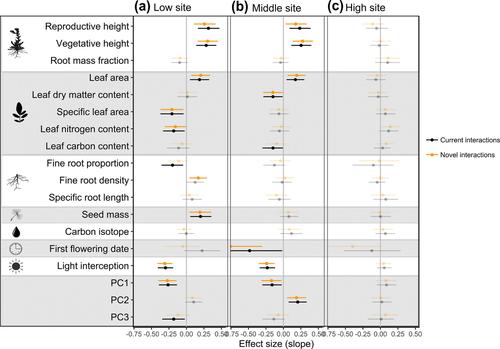当前位置:
X-MOL 学术
›
Glob. Change Biol.
›
论文详情
Our official English website, www.x-mol.net, welcomes your
feedback! (Note: you will need to create a separate account there.)
Functional Traits Predict Outcomes of Current and Novel Competition Under Warmer Climate
Global Change Biology ( IF 10.8 ) Pub Date : 2024-11-04 , DOI: 10.1111/gcb.17551 Shengman Lyu, Jake M. Alexander
Global Change Biology ( IF 10.8 ) Pub Date : 2024-11-04 , DOI: 10.1111/gcb.17551 Shengman Lyu, Jake M. Alexander

|
Functional traits offer a potential avenue to generalize and forecast the impacts of changing competition on plant communities, including changing outcomes of competition among species that currently interact (current competition) or that will interact in the future following range shifts (novel competition). However, it remains unclear how well traits explain variation in the outcomes of current and novel competition as well as the underlying processes determining coexistence or competitive exclusion, under changing climate. Here, we interacted pairs of high and low‐elevation species in three sites across an elevation gradient in the Swiss Alps. For each species pair, we quantified the population‐level outcomes of competition (invasion growth rates), relative fitness differences, and niche overlap and related these to 15 functional traits that were measured in each site. Most traits were significantly associated with invasion growth rates at the low elevation, where species had greater relative fitness differences, but these associations were much weaker towards higher elevations. This appears to be because traits, particularly those associated with light competition, captured species' relative fitness differences at lower elevations, but not at the high elevation site, highlighting that the predictive ability of traits can depend on environmental context. The amplified relative fitness differences towards lower elevations suggest that climate warming may increase the likelihood of competitive exclusion. In addition, novel competitors tended to show greater niche overlap than current competitors, leading to stronger overall competitive effects. However, in general, trait differences predicted competitive outcomes of novel and current competitors similarly well, suggesting that traits can predict interactions between species that do not yet interact. Our study reinforces the importance of considering changing interactions for predicting species responses to climate change and provides experimental evidence supporting the usefulness of functional trait differences in forecasting the impacts of future plant interactions under changing climate.
中文翻译:

功能特征预测温暖气候下当前和新竞争的结果
功能性状为推广和预测不断变化的竞争对植物群落的影响提供了一种潜在的途径,包括当前相互作用的物种之间的竞争结果的变化(当前竞争)或未来范围变化后将相互作用的物种之间的竞争结果(新的竞争)。然而,目前尚不清楚性状如何解释当前和新竞争结果的变化,以及在不断变化的气候下决定共存或竞争排斥的潜在过程。在这里,我们在瑞士阿尔卑斯山的海拔梯度上的三个地点对高海拔和低海拔物种进行了互动。对于每个物种对,我们量化了竞争(入侵增长率)、相对适应度差异和生态位重叠的种群水平结果,并将这些与在每个地点测量的 15 个功能性状相关联。大多数性状与低海拔地区的入侵增长率显著相关,其中物种的相对适应性差异更大,但这些关联在高海拔地区要弱得多。这似乎是因为性状,特别是那些与光竞争相关的性状,捕捉到了物种在低海拔地区的相对适应性差异,但在高海拔地区没有捕捉到物种的相对适应性差异,这突出表明性状的预测能力可能取决于环境背景。向低海拔地区放大的相对适应度差异表明,气候变暖可能会增加竞争性排斥的可能性。此外,与当前竞争对手相比,新型竞争对手往往表现出更大的利基重叠,从而导致更强的整体竞争效应。 然而,一般来说,性状差异对新竞争者和当前竞争者的竞争结果的预测效果相似,这表明性状可以预测尚未相互作用的物种之间的相互作用。我们的研究强调了考虑变化相互作用对预测物种对气候变化的反应的重要性,并提供了实验证据,支持功能性状差异在预测气候变化下未来植物相互作用的影响方面的有用性。
更新日期:2024-11-04
中文翻译:

功能特征预测温暖气候下当前和新竞争的结果
功能性状为推广和预测不断变化的竞争对植物群落的影响提供了一种潜在的途径,包括当前相互作用的物种之间的竞争结果的变化(当前竞争)或未来范围变化后将相互作用的物种之间的竞争结果(新的竞争)。然而,目前尚不清楚性状如何解释当前和新竞争结果的变化,以及在不断变化的气候下决定共存或竞争排斥的潜在过程。在这里,我们在瑞士阿尔卑斯山的海拔梯度上的三个地点对高海拔和低海拔物种进行了互动。对于每个物种对,我们量化了竞争(入侵增长率)、相对适应度差异和生态位重叠的种群水平结果,并将这些与在每个地点测量的 15 个功能性状相关联。大多数性状与低海拔地区的入侵增长率显著相关,其中物种的相对适应性差异更大,但这些关联在高海拔地区要弱得多。这似乎是因为性状,特别是那些与光竞争相关的性状,捕捉到了物种在低海拔地区的相对适应性差异,但在高海拔地区没有捕捉到物种的相对适应性差异,这突出表明性状的预测能力可能取决于环境背景。向低海拔地区放大的相对适应度差异表明,气候变暖可能会增加竞争性排斥的可能性。此外,与当前竞争对手相比,新型竞争对手往往表现出更大的利基重叠,从而导致更强的整体竞争效应。 然而,一般来说,性状差异对新竞争者和当前竞争者的竞争结果的预测效果相似,这表明性状可以预测尚未相互作用的物种之间的相互作用。我们的研究强调了考虑变化相互作用对预测物种对气候变化的反应的重要性,并提供了实验证据,支持功能性状差异在预测气候变化下未来植物相互作用的影响方面的有用性。


















































 京公网安备 11010802027423号
京公网安备 11010802027423号